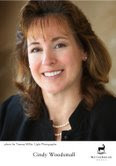 Cindy Woodsmall is an author, wife, and mother of three sons. Her first novel released in 2006 to much acclaim, including a Reviewer’s Choice Award from the Road to Romance website, and became a CBA bestseller. Her real-life connections with Amish Mennonite and Old Order Amish families enrich her novels with authenticity. She lives in Georgia with her husband and the youngest of their three sons.
Cindy Woodsmall is an author, wife, and mother of three sons. Her first novel released in 2006 to much acclaim, including a Reviewer’s Choice Award from the Road to Romance website, and became a CBA bestseller. Her real-life connections with Amish Mennonite and Old Order Amish families enrich her novels with authenticity. She lives in Georgia with her husband and the youngest of their three sons. Visit Novel Reviews for a review of When the Morning Comes.
At midnight, during the heat of summer in Georgia, my youngest son and I went to the train depot. The building was dark. In spite of its abandoned look from the outside, the door to the place actually opened. Inside was a small, empty room, with three pews that appeared to date back to the Civil War. I didn’t expect any other passengers to be there, but I did think there would be at least one employee.
I was wrong.
I smiled at my nine-year-old, assuring him the train would stop for us and that it would have people on it.
After waiting for close to two hours, the train did arrive and we began our eighteen-hour jaunt, changing trains in Philadelphia before arriving in Harrisburg, Pennsylvania.
At the time, I was an aspiring writer, and my Amish character would ride a train. So the experience was a means of both doing research and getting to Pennsylvania to meet with an Amish woman.
This trip proved invaluable to me. By going to the places my character went in the story, and living through the experiences my character lived firsthand, I was able to write my story with far more insight than if I hadn’t gone there in person. There are times when books, television, a phone interview or the Internet are sufficient means of research, but those can lack key ingredients for getting inside the skin, heart, and mind of a character.
If your character is on a dusty trail during the dog days of summer, you can’t experience the difficulties of living in that temperature, hear the sounds made during that season in that location, or breathe in the nuances of the aromas of dawn, noon, and midnight through books, television, telephone or the Internet.
Even just a few days of living like your character can make all the difference, not just in the details that need to be written from an author’s point of view, but in the five senses a character experiences in the midst of the conflict and crises going on in the book.
When I boarded that train at nearly two in the morning, it was my first time to travel by train other than a commuter. The sounds of the sleeper car, the g-force of the train as it stopped and started for each depot, the aroma of the private cars versus the dining car—all of it came to life.
I also learned that traveling as a lone female with a young son in tow wasn’t easy. So what would my character—Hannah, an Old Order Amish girl of seventeen who was away from home for the first time, fearful of getting caught, and afraid of moving forward—feel, think, and do? After taking the train ride and living at the location of my book myself, I had the keys to help readers climb into the story and experience it with my character.
I was wrong.
I smiled at my nine-year-old, assuring him the train would stop for us and that it would have people on it.
After waiting for close to two hours, the train did arrive and we began our eighteen-hour jaunt, changing trains in Philadelphia before arriving in Harrisburg, Pennsylvania.
At the time, I was an aspiring writer, and my Amish character would ride a train. So the experience was a means of both doing research and getting to Pennsylvania to meet with an Amish woman.
This trip proved invaluable to me. By going to the places my character went in the story, and living through the experiences my character lived firsthand, I was able to write my story with far more insight than if I hadn’t gone there in person. There are times when books, television, a phone interview or the Internet are sufficient means of research, but those can lack key ingredients for getting inside the skin, heart, and mind of a character.
If your character is on a dusty trail during the dog days of summer, you can’t experience the difficulties of living in that temperature, hear the sounds made during that season in that location, or breathe in the nuances of the aromas of dawn, noon, and midnight through books, television, telephone or the Internet.
Even just a few days of living like your character can make all the difference, not just in the details that need to be written from an author’s point of view, but in the five senses a character experiences in the midst of the conflict and crises going on in the book.
When I boarded that train at nearly two in the morning, it was my first time to travel by train other than a commuter. The sounds of the sleeper car, the g-force of the train as it stopped and started for each depot, the aroma of the private cars versus the dining car—all of it came to life.
I also learned that traveling as a lone female with a young son in tow wasn’t easy. So what would my character—Hannah, an Old Order Amish girl of seventeen who was away from home for the first time, fearful of getting caught, and afraid of moving forward—feel, think, and do? After taking the train ride and living at the location of my book myself, I had the keys to help readers climb into the story and experience it with my character.
How does one create a fictional character? I begin by developing the character’s backstory: who her parents were and how she was raised. This makes the character more real to me. Knowing some key elements of your characters’ childhood makes it easier to visualize what makes them tick, why they feel certain ways, and how they developed their own unique goals, fears, and strengths.
Then I add details of the character’s personality and traits.
I sometimes think of a character’s natural tendencies in terms of a type of animal. I’m not saying we humans are stuck in our ways like an animal is to its instincts, but this kind of comparison helps me understand my characters and keep them consistent.
A beaver, for example, is energetic, working from dusk to dawn cutting wood to use in dams or lodges. When it stops for a spell, it’s a deliberate break in order to accomplish something else: eating, grooming, sleeping or taking care of young. A pet dog, on the other hand, tends to lie around for hours, then get up and chase its tail, bark at nothing, take a ball to its master with the hopes of a game of catch, then go back to lying around.
When developing a fictional character, you may want to think of an animal that typifies that character’s personality. This will help you define who your characters are and develop them in a way that’s consistent to their nature . . . unless you’re deliberately showing growth through a learning-curve journey you’ve put them on.
Once you’ve established a character’s family situation, childhood experiences, and natural bent, you’re ready to go on location and experience the surroundings as your character would.
Because a premature baby would be part of my story in When the Heart Cries, I sought permission to enter a neonatal intensive care unit with the department head. I spent time beside the incubators on a few occasions, watching these tiny beings fight for life. The aromas, sounds, and feel of these newborns were totally different from holding my own full-term babies. The diapers for these infants are so tiny I still get chills. How much deeper would I have felt about this experience if I’d given birth to such a child, outside of a hospital, and if I’d been raised without the numbing effect of news, television or movies? What would my reaction have been if my life’s goal was centered on having children and I’d been trained in the Old Ways, where a young woman never had a thought about who she could be as an individual, but only whose mother she would become?
I went to Alliance, Ohio, in the dead of night in winter to see what Hannah would face when stepping off a train at two a.m. in When the Morning Comes. It wasn’t about the logistics of what was or wasn’t at the depot. That became a natural part of the story. The trip was about living inside Hannah, in all her Old Order Amish ways, as she struggled to survive until morning.
Getting to know your character’s family, childhood, and personality tells you who they are abstractly. Going to the location of the story shows what your characters experience concretely. Meshing the two gives writers the freedom to explore life as if they were someone else. Then they can take their readers on journeys so filled with rich detail they will be truly unforgettable.
Then I add details of the character’s personality and traits.
I sometimes think of a character’s natural tendencies in terms of a type of animal. I’m not saying we humans are stuck in our ways like an animal is to its instincts, but this kind of comparison helps me understand my characters and keep them consistent.
A beaver, for example, is energetic, working from dusk to dawn cutting wood to use in dams or lodges. When it stops for a spell, it’s a deliberate break in order to accomplish something else: eating, grooming, sleeping or taking care of young. A pet dog, on the other hand, tends to lie around for hours, then get up and chase its tail, bark at nothing, take a ball to its master with the hopes of a game of catch, then go back to lying around.
When developing a fictional character, you may want to think of an animal that typifies that character’s personality. This will help you define who your characters are and develop them in a way that’s consistent to their nature . . . unless you’re deliberately showing growth through a learning-curve journey you’ve put them on.
Once you’ve established a character’s family situation, childhood experiences, and natural bent, you’re ready to go on location and experience the surroundings as your character would.
Because a premature baby would be part of my story in When the Heart Cries, I sought permission to enter a neonatal intensive care unit with the department head. I spent time beside the incubators on a few occasions, watching these tiny beings fight for life. The aromas, sounds, and feel of these newborns were totally different from holding my own full-term babies. The diapers for these infants are so tiny I still get chills. How much deeper would I have felt about this experience if I’d given birth to such a child, outside of a hospital, and if I’d been raised without the numbing effect of news, television or movies? What would my reaction have been if my life’s goal was centered on having children and I’d been trained in the Old Ways, where a young woman never had a thought about who she could be as an individual, but only whose mother she would become?
I went to Alliance, Ohio, in the dead of night in winter to see what Hannah would face when stepping off a train at two a.m. in When the Morning Comes. It wasn’t about the logistics of what was or wasn’t at the depot. That became a natural part of the story. The trip was about living inside Hannah, in all her Old Order Amish ways, as she struggled to survive until morning.
Getting to know your character’s family, childhood, and personality tells you who they are abstractly. Going to the location of the story shows what your characters experience concretely. Meshing the two gives writers the freedom to explore life as if they were someone else. Then they can take their readers on journeys so filled with rich detail they will be truly unforgettable.
























So great to hear the heart of a writer. Keep up the good work Cindy!
ReplyDeleteThanks, Cindy.
ReplyDeleteI don't think I want to know what thriller/suspense authors do to experience what they write about. shudder. The train ride sounds heavenly...especially with WiFi and no kids. : )
I love that you research and experiencing what you write as much as you do, Cindy. It shows in the writing, too. I can't wait for #3. :o)
ReplyDeleteExcellent article, Cindy. Thanks for that.
ReplyDeleteWow, Cindy. I didn't know you researched to that extent. What a great thing and I can't wait to read the latest novel.
ReplyDeleteCindy, (this is Don's daughter) I loved the book, seriously! It was full of detail and I was swallowed by the story. I haven't seen you in so many years, but its nice to see you are doing so well. Please keep writing! Check out what I'm doing at www.myspace.com/jessicaparksmusic
ReplyDeleteYour Niece,
Jessica Woodsmall McNabb